Exploring the Pentatomidae: Anatomy and Ecology
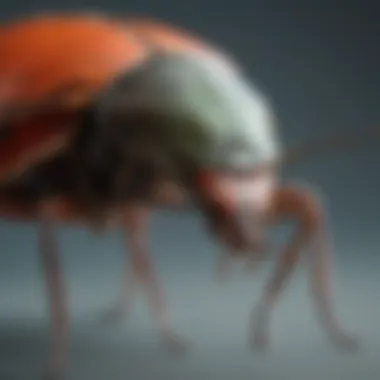
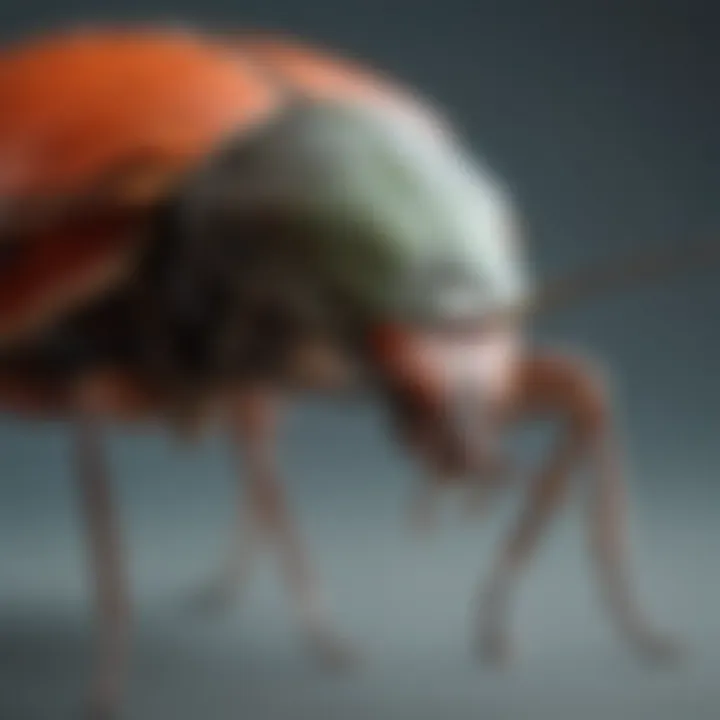
Intro
Delving into the world of Pentatomidae, or what most people call shield bugs, reveals a complex tapestry woven from their anatomy, ecology, and significance in nature. These insects, easily recognizable by their unique shape and odorous defense mechanisms, serve as more than just a curiosity in the ecosystem. By exploring them, we can begin to comprehend their roles as both insectivores and potential pests.
Intro to Pentatomidae
The family Pentatomidae, often referred to as shield bugs or stink bugs, offers a critical lens through which we can gauge the intricate tapestry of nature. Their significance lies not just in their distinctive appearance but also in their multifaceted roles in various ecosystems. This family serves as a prime example of how seemingly simple organisms can serve complex ecological functions, from predation to mutualist interactions. As we delve deeper into the Pentatomidae, it becomes clear that understanding their various biological and ecological attributes unfolds a greater comprehension of biodiversity and its conservation.
Defining the Family
Pentatomidae stands out within the realm of entomology due to its extensive diversity and adaptability. These insects typically showcase a flattened, shield-like body shape, which they utilize for camouflage and defense against predators. Shield bugs often exhibit vibrant colors and patterns that can inform us about their ecological niches and survival strategies. The innate characteristics that define this family also touch upon their feeding habits, often as herbivores, but also as predators in certain contexts—an aspect that underscores their adaptability and evolutionary success.
Pentatomidae generally possess piercing-sucking mouthparts that allow them to extract sap from plants or puncture the exoskeletons of smaller insects. This feeding mechanism not only highlights their ecological versatility but also poses significant implications for agriculture. Stink bugs can be notorious pests, leading to considerable crop damage if left unchecked.
To further appreciate the Pentatomidae, a closer look at their behavioral tendencies and adaptability to various environments is essential, as these features play a critical role in their survival and reproduction.
Historical Context and Taxonomy
The history of Pentatomidae is as tangled as a fresh ball of yarn. This family of insects has been around for millions of years, showcasing a noteworthy evolutionary journey. Taxonomists split them into several subfamilies and genera, showcasing the vast range of characteristics exhibited by different members of this family. Historically, studies regarding Pentatomidae began as far back as the late 18th century, with entomologists classifying various species based on morphological traits.
As research in genetics and molecular biology progressed, our understanding of these insects expanded robustly, leading to more nuanced classifications and the identification of cryptic species once thought to be a single entity. For instance, molecular phylogenetics has shed light on the evolutionary relationships within the Pentatomidae, revealing unexpected lineages and connections between species.
"The evolution of the Pentatomidae family underscores the dynamic nature of environmental adaptation and resilience."
In present-day studies, this historical context intertwines with contemporary challenges, as scientists continue to catalog species while also addressing conservation efforts. Learning about the Pentatomidae's evolutionary past informs future research directions, especially as habitat changes threaten numerous species. Understanding both their taxonomy and historical context is not merely an academic exercise but a crucial endeavor for preserving biodiversity in the face of increasingly diverse environmental challenges.
Morphological Characteristics
The study of Morphological Characteristics in Pentatomidae is integral for understanding this fascinating family of insects. The physical structures and forms found in shield bugs not only define their identity but also reflect their adaptation to various environments. A closer examination into the body structure and sensory adaptations reveals critical insights into their behavior, survivability, and their ecological roles in different habitats.
Body Structure
Exoskeleton Composition
The exoskeleton of Pentatomidae is a vital feature worth discussing. It is primarily composed of a tough external layer made of chitin, providing both protection and support. Chitin is a remarkable biopolymer that allows these insects to endure predation, weather, and other environmental stresses. One notable characteristic of the exoskeleton is its rigidity, which effectively shields them against injury. This protective trait is particularly beneficial for shield bugs that find themselves in hostile environments or when encountering predators.
Unique features of the exoskeleton also include its ability to change in coloration as Pentatomidae molt through their life stages. Although this rigidity serves as a stronghold against physical threats, it comes at a price. The hard exoskeleton limits flexibility, which can impair rapid movement while they feed or evade predators. Therefore, while the exoskeleton composition is largely advantageous, it can also be a limiting factor in certain situations.
Coloration and Patterns
The coloration and patterns exhibited by shield bugs serve various purposes, enhancing both their survival and reproduction. These insects often display vivid colors and intricate designs that can act as camouflage, blending seamlessly into their surroundings like the foliage or flowers they inhabit. This adaptive coloration is crucial for hiding from predators, safeguarding them from becoming a meal.
Moreover, the patterns on their bodies can also play a role in social signaling, especially during mating. For instance, specific colorations can attract mates or fend off rivals. Among species, variations in color can be stark; certain bugs exhibit brilliant hues while others prefer duller tones.
However, with these benefits might come disadvantages. Brightly colored species, while they may appear attractive or healthy to potential mates, can attract predators as well. Thus, their coloration, although advantageous, is a double-edged sword, representing a delicate balance between interspecies communication and survival tactics.
Sensory Adaptations
Sensory adaptations in Pentatomidae are equally crucial. These adaptations help the insects navigate through their environment, locate food sources, and avoid threats.
Compound Eyes
The compound eyes of shield bugs are one of their key adaptations. Unlike simple eyes, compound eyes are composed of numerous small facets, allowing these insects to have a wide field of vision. This is particularly beneficial for spotting predators approaching from various angles.
Additionally, their eyes can detect a range of wavelengths, helping them to identify both potential food sources and mates. The unique aspect of their vision is that it allows for excellent motion detection, enabling a swift response to any sudden movement nearby. In environments filled with potential threats, having such acute perception can make all the difference between life and death for these insects.
Yet, on the downside, the complexity of the compound eyes may also make them vulnerable to mechanical damage. For instance, certain environmental conditions may hinder their visual function—like heavy rain which can obscure vision and impede their ability to respond effectively.
Antennae Functionality
Antennae serve multiple functions, significantly contributing to the overall sensory capabilities of Pentatomidae. Their antennae are long and segmented, designed for heightened tactile perception and chemical sensing. This functionality allows these insects to gather information about their environment, forage for food, assess habitat conditions, and locate mates.
Each segment of the antenna can detect different chemical signals in the air, aiding in recognizing plant health or the presence of predators or rivals nearby. The notable characteristic here is the antennae's role in chemical signaling, which influences not just individual behaviors but can impact whole populations through pheromone communication.
However, while these sensory tools are useful, they are also sensitive to damage, which may limit the insect's ability to navigate or communicate effectively, indicating a trade-off between sensitivity and durability.
"The intricate balance of evolutionary traits showcases not only how species adapt but also their delicate dance with survival in their ecological dance floor."
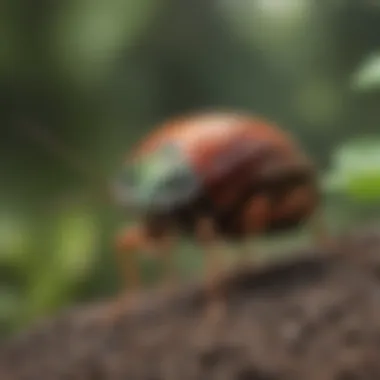
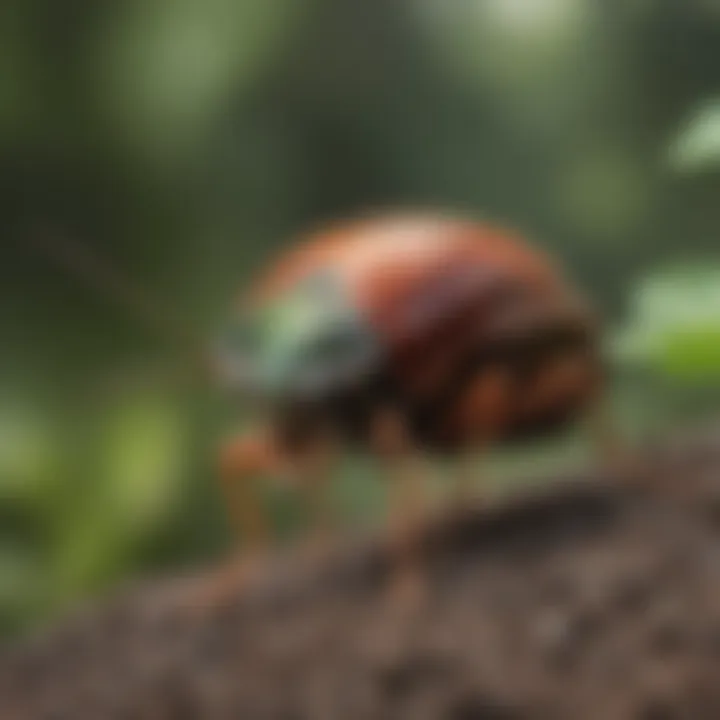
By delving into these morphological traits, it becomes clear that they are not just parts of the insects’ physiology; they are indispensable elements that enhance the ecological relevance of Pentatomidae in their natural habitats.
Life Cycle and Development
The life cycle and development of the Pentatomidae family are pivotal to understanding their various ecological roles and interactions within their environments. This family of insects, often recognized as shield bugs or stink bugs, undergoes distinct stages that contribute significantly to their biology. By focusing on egg formation, hatching processes, nymphal stages, and adult characteristics, we can uncover details that highlight their adaptability, growth patterns, and survival strategies.
Egg Stage
Egg Formation
The egg formation stage of Pentatomidae is not just a mere precursor to adulthood; it’s a fascinating process that encapsulates the beginning of life for these insects. Females typically lay their eggs in clusters, often hidden under leaves or in the soil, which provides some level of protection from predators.
What makes this aspect especially noteworthy is the material composition of the eggs. They possess a flexible outer shell that allows for slight expansion as the embryos develop inside, a characteristic that showcases the evolutionary adaptations of these insects. This trait is beneficial as it facilitates a better environment for the growing embryos, allowing them to thrive until hatching.
A unique feature here is that the female shield bug often chooses specific host plants for egg-laying, which ensures that the resulting nymphs have immediate access to food upon hatching. This choice of plant is essential to their survival, providing a natural resource that significantly boosts their chances of reaching maturity.
Hatching Process
As the time for hatching approaches, several intriguing transformations occur. The hatching process is characterized by the nymphs breaking free from their eggs, which can happen within a couple of weeks, depending on environmental conditions. This quick turnaround can be a crucial survival advantage, especially in areas with potential predation risks.
The main characteristic of the hatching is the synchronized emergence of the nymphs. This timing allows them to collectively evade predators, a strategy that underscores the importance of social behavior even at such an early life stage. Furthermore, the unique aspect of this process is the soft exoskeleton of the nymphs during hatch, which hardens shortly after, providing necessary protection.
This ability to hatch in synchrony is beneficial but also serves as a double-edged sword. While it helps evade early predators, it can also lead to a higher resource demand that may not always be met in certain habitats, indicating a delicate balance within their ecological niche.
Nymphal Stages
Developmental Changes
The nymphal stages mark a significant phase in the life of Pentatomidae. These stages are characterized by several molts, where the nymphs shed their exoskeletons as they grow. This process is crucial for their development as it allows them to increase in size and prepare for eventual adulthood. Each molt brings about subtle yet noticeable morphological changes, including variations in coloration and size, which can make them less appealing as prey and more adept at hunting.
What’s compelling about developmental changes is the insight it provides into ecological adaptability. The enhanced physical characteristics help them blend into their surroundings, a significant advantage in avoiding predators. This camouflage plays an essential role in their continued survival within specified ecosystems.
The nymphs also undergo behavioral adaptations during this stage, beginning to exhibit foraging behaviors that align with their adult counterparts. Notably, their habits can shift from simple piercing and sucking of plant sap to hunting smaller insects as they progress through the nymphal stages.
Feeding Habits
Feeding habits during the nymphal stages of Pentatomidae are diverse and can have profound effects on their chosen habitats and the plants surrounding them. Nymphs primarily feed on plant sap, but they also display some flexibility in their diets, occasionally preying on smaller insects. This dual approach to feeding not only sustains their growth but also positions them as important actors within the food web.
The key characteristic of their feeding strategy is the use of their specialized mouthparts, which are adapted for piercing plant tissue. This allows them to extract nutrients while minimizing damage to their food sources, showcasing a degree of ecological balance. Such behavior can be beneficial for crops, especially when there are no significant pest pressures, as it facilitates pollination and growth.
On the flip side, their feeding habits can lead to significant agricultural impacts, particularly when they infest crops in large numbers. This poses challenges in pest management, highlighting the complex relationship between this family of insects and human agricultural practices.
Adult Characteristics
Reproductive Strategies
The reproductive strategy of adult Pentatomidae is a multifaceted dance, combining various approaches to ensure the continuity of their lineage. Adults engage in complex courtship behaviors, often involving pheromone signaling and tactile interactions to attract mates.
One striking feature is the timing of their reproductive activities, which is typically aligned with favorable environmental conditions, ensuring that the eggs are laid when resources are abundant. This is a beneficial choice as it maximizes the likelihood of offspring survival.
However, the reproductive strategies also come with their challenges. High population densities can lead to increased competition, affecting mating success and potentially delaying reproduction under adverse conditions, emphasizing the tenuous balance maintained in their ecosystems.
Lifespan Variability
Lastly, the lifespan of adult Pentatomidae can vary significantly based on numerous factors, including environmental conditions, food availability, and predation pressures. Typically, adults can live from several months to a year, with some species exhibiting remarkable longevity.
A unique feature of this variability is the influence of seasonal changes. Adults often undergo strategies such as diapause or behavioral changes to survive unfavorable conditions, indicating their resilience and adaptability. Understanding this aspect of their life cycle assists in predicting population dynamics and informs agricultural practices for pest control.
In summary, the life cycle and development of the Pentatomidae highlight essential elements that underscore their ecological significance. Each stage, from egg to adult, reflects a continuous adaptation to their environments, showcasing their role in pest control, biodiversity, and agricultural narratives. By dissecting these stages, we can appreciate the complexities of their life histories and the challenges they face.
Ecological Roles
The Pentatomidae family, often recognized simply as stink bugs or shield bugs, occupies a unique position within various ecosystems. Their ecological roles are significant, affecting not only their immediate environment but also broader ecological dynamics. Understanding these roles helps to highlight their value in both natural habitats and agricultural settings.
Predator and Prey Dynamics
Food Web Interactions
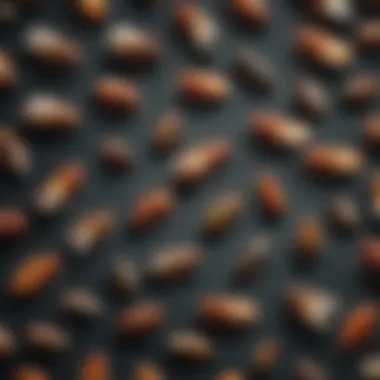

Food web interactions involving Pentatomidae are intricate and critical for ecosystem stability. These insects serve as both predators and prey, positioning them as essential players in maintaining balance. Their predatory behavior often targets softer-bodied pests like aphids or caterpillars. In turn, they contribute to the regulation of these populations, preventing overgrowth that could devastate plant life.
The uniqueness of these interactions lies in how Pentatomidae adaptively switch between being predators and prey. For instance, within certain environments, they might find their diet primarily consisting of plant matter, shifting only towards predation during high pest populations. This flexibility makes them a valuable asset in the agricultural realm, where maintaining crop health is of utmost importance.
One of the appealing characteristics of their role in food webs is their adaptability. However, they also face their own predators, which makes their inclusion in these dynamics perpetually engaging.
Role in Pest Control
In the agricultural context, one cannot overlook the role of Pentatomidae in pest control, serving as a natural form of regulation against numerous crop pests. Their predation not only diminishes pest populations but also lessens the need for chemical pest control measures, offering a more sustainable avenue for farmers. This aspect of their ecology lends them considerable significance in integrated pest management strategies.
The key characteristic of their pest control role is their voracious appetite for common agricultural nuisances. This makes them a beneficial ally in fields where crops like tomatoes or soybeans are growing, potentially conserving both resources and environment.
Yet, while one may laud their contributions, it is also important to recognize that certain species within the family can themselves become pests. This duality highlights the complexities of their ecological roles.
Symbiotic Relationships
Mutualism Examples
Mutualistic relationships are key highlights of the ecology surrounding Pentatomidae. Certain species have been found to engage in beneficial interactions with plants, particularly in terms of providing protection against other herbivores. For example, stink bugs can deter more significant threats to the plants by their mere presence or feeding behavior, ultimately contributing to their host plant's health.
This dynamic is a beneficial choice for exploring ecological interactions, showcasing not just predator-prey relationships but also how organisms can co-evolve to enhance each other’s survival.
Furthermore, there's a unique feature in how these relationships function. By attracting predator species of herbivores, these bugs initiate a chain reaction that bolsters the resilience of the ecosystem overall, allowing for greater biodiversity and stability. However, this can raise some questions around the constant balancing act needed to assess when a relationship turns harmful.
Parasitism Instances
On a more complex note, parasitism presents a darker side of the relationships Pentatomidae engage in. Some parasites can exploit these insects, affecting their health and survival. These interactions can disrupt their roles as predators or contributors to ecological balance, echoing significant implications for their populations and the climate of biodiversity overall.
The interesting aspect of parasitism in this context lies in its potential to both weaken pest populations while simultaneously threatening the health of the beneficial pentatomids themselves. Understanding how these instances occur and influence populations is a pressing concern for research.
In summary, the ecological roles of Pentatomidae introduce a nuanced understanding of their positions as both protectors and threateners within ecosystems. Their roles align with the balance of predator and prey dynamics and highlight crucial ecological relationships that serve agriculture and nature alike.
Economic Importance
The economic significance of the Pentatomidae family, commonly recognized as shield bugs or stink bugs, extends far beyond their mere presence in ecosystems. Their roles in both agriculture and culture underscore why understanding these insects is crucial for both scientific communities and the general public alike.
Agricultural Impact
Crops Affected
Pentatomidae species often target a range of crops that are vital to agricultural economies. Some crops significantly impacted by these bugs include:
- Soybeans: Known for being a major protein source, soybeans are staples in livestock feed and a key ingredient in numerous food products. Shield bugs can severely damage soybean plants, inhibiting their growth and yielding potential.
- Corn: This crop serves as a fundamental energy source. Shield bugs feed on the plant's sap, leading to poor kernel development and, in severe cases, plant death.
- Tomatoes: These are not only essential for culinary purposes but also a prominent cash crop. Infestations can result in blemished fruits and predispose plants to decay.
The highlighted crops are not just popular; they are central to food systems and economies globally. The damage caused by Pentatomidae disrupts not only supply chains but also market stability. Without effective management, pests like shield bugs can turn fertile land into barren fields, affecting food security and farmer livelihoods.
Management Strategies
Mitigating the impact of these pests requires comprehensive management strategies. These strategies can often include:
- Integrated Pest Management (IPM): This holistic approach combines biological control, habitat manipulation, and resistant varieties to reduce pest populations without heavy reliance on chemical pesticides.
- Cultural Controls: Crop rotation and planting pest-resistant crop varieties reduce the chances of infestation.
- Chemical Controls: While sometimes necessary, the judicious use of pesticides ensures that beneficial insects remain unharmed, maintaining ecosystem balance.
The intriguing aspect of these management strategies is their adaptability. For instance, in varied climates, specific pest control measures might work more effectively. While effective, these methods often come with trade-offs. Increased chemical use raises concerns regarding environmental health, while cultural practices require more knowledge and labor from farmers.
Cultural Significance
Representation in Folklore
In various cultures, Pentatomidae have found their way into folklore and myths, often representing transformation or resilience. For instance, in some regions, shield bugs are thought to symbolize prosperity, as their presence is interpreted as a sign of a bountiful harvest due to their association with agricultural crops.
A characteristic feature of folklore around these insects is their transformation stories, where the humble stink bug undergoes a metamorphosis to signify abundance of resources or good fortune in farming.
Such tales showcase how these insects are ingrained in cultural narratives, demonstrating their permeation into human consciousness. They serve not only as agricultural players but as symbols that reflect people's values and beliefs.
Symbolic Uses in Art
In the realm of art, Pentatomidae often emerge as subjects that reveal the interconnectedness of life cycles and ecosystems. Artists frequently utilize the unique appearance of these bugs to explore themes like nature’s resilience and the balance between beauty and utilitarianism.
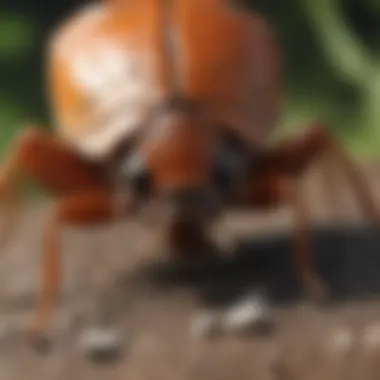
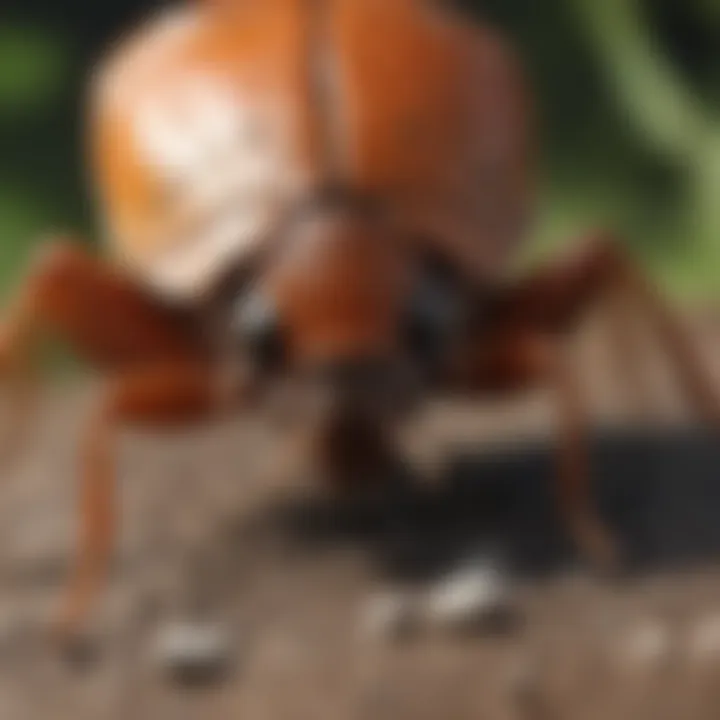
Their striking patterns and shapes provide a rich source of inspiration for visual creators. For example, in textile design, the intricate coloration of shield bugs can lead to striking patterns that captivate the eye, while simultaneously prompting conversations about nature and biodiversity. However, one key disadvantage is that reliance on natural motifs can sometimes veer into kitsch, losing its essence in overexposure.
Understanding the economic implications of Pentatomidae helps bridge the gap between ecological awareness and cultural representation.
In summary, the economic importance of the Pentatomidae family encompasses their direct agricultural effects and their broader cultural roles, affirming their vital place in both ecosystems and human society. Whether it’s managing pest populations or celebrating their symbolism in art and folklore, recognizing shield bugs' multifaceted significance can enhance our approach to biodiversity and sustainability.
Conservation and Biodiversity
The conservation of Pentatomidae species is a crucial aspect in the broader context of biodiversity. This family, known for its ecological roles and economic significance, faces several risks that can allow their populations to dwindle, ultimately affecting ecosystem balance and agricultural practices. Understanding the factors influencing their conservation not only aids in preserving these insects but also enhances our grasp of environmental sustainability.
Threats to Pentatomidae Species
Habitat Loss
One of the primary challenges to Pentatomidae species is habitat loss. This phenomenon stems mostly from urbanization, agriculture expansion, and deforestation, converting rich ecosystems into barren lands. The key characteristic here is that as these bugs lose their natural environment, their populations struggle to thrive. Habitat loss is a relevant focal point because it illustrates a direct link between human activities and declines in insect diversity.
The unique feature of habitat loss is the fragmentation of their living spaces. This results in isolated populations that find it difficult to mate, access food, or migrate. The advantages of acknowledging habitat loss in this discussion include drawing attention to conservation strategies that aim to protect critical habitats, yet it does highlight the challenges that come along with restoration. The detrimental effects can cascade through the food web, resulting in a loss of species that rely on Pentatomidae.
Climate Change Impacts
Climate change is another significant risk factor affecting Pentatomidae. Increased temperatures and changing weather patterns can disrupt their life cycles and feeding patterns. The key aspect to note is that climate change acts as a stressor that can exacerbate other threats, such as habitat loss by altering available conditions for survival.
The unique feature of climate change in this context is its unpredictable nature. It brings irregular seasonal shifts that can lead to mismatches in the timing of life cycle events, sometimes resulting in poor reproductive success. Exploring climate impacts helps paint a vivid image of what these species face today. The advantages of shedding light on these risks include fostering awareness of more substantial environmental challenges, but, obviously, it opens a can of worms regarding broader strategies necessary for effective mitigation.
Conservation Efforts
Protected Areas
Creating protected areas can serve as a refuge for Pentatomidae species, allowing their populations to recover and maintain stability. These areas offer a significant buffer against habitat loss and provide a safe space for various life forms. The standout characteristic of protected areas is their capacity to integrate diverse ecosystems under conservation strategies, supporting rich biodiversity.
Their unique advantage lies in preserving habitats that might otherwise be irreversibly damaged. Such strategies might require collaboration between government organizations, local communities, and conservation groups. However, the challenge can arise when enforcing protection and ensuring that human activities comply with preservation goals.
Research Initiatives
Research initiatives are essential in understanding the biology and ecology of Pentatomidae. Such studies can lead to more effective conservation strategies. The highlight of this area is that ongoing research can offer insights into the population dynamics and behaviors of these bugs, contributing to better management practices.
These initiatives help fill knowledge gaps surrounding these species, granting a solid foundation for evidence-based decisions. One unique aspect of research efforts is their adaptability; as new findings surface, strategies can pivot to be more effective. However, pursuing thorough research can require considerable time and resources, which sometimes poses challenges in funding and prioritization.
In summary, effective conservation strategies that address threats like habitat loss and climate change will contribute to maintaining the rich diversity of Pentatomidae while fostering ecosystem resilience.
End
The exploration of the Pentatomidae family underscores their multifaceted importance within both ecological and economic realms. Understanding these creatures provides insights into not only their unique anatomical traits and roles within their habitats but also highlights significant interactions with humans and the environment. These bugs, often overlooked, play pivotal roles in agricultural ecosystems, both as pests and as agents of pest control through their predation on harmful species. Therefore, comprehending their behavior and life cycles can lead to more informed and effective management strategies in agriculture.
Recap of Key Points
In revisiting the main ideas discussed throughout this article, a few crucial points stand out:
- Diversity and Anatomy: The family Pentatomidae houses a diverse range of species, each with unique morphological features such as robust bodies and distinctive exoskeleton patterns.
- Ecological Roles: These insects contribute to food web dynamics by acting as both predators and prey, and they also engage in symbiotic relationships that enhance their survival.
- Economic Impact: Their influence on agriculture can be negative, seen in pest status, but also positive, with contributions to biodiversity and pest management practices.
- Conservation Concerns: Threats like habitat destruction and climate change are pressing issues, warranting attention in terms of conservation initiatives aimed at preserving various Pentatomidae species.
Implications for Future Research
Looking forward, there are numerous avenues for further exploration regarding Pentatomidae. Improved understanding of their specific ecological interactions could bolster strategies for agricultural sustainability. Some potential research areas include:
- Behavioral Studies: Investigating how different species interact with their ecosystems under varying environmental conditions could yield valuable data on resilience and adaptability.
- Conservation Strategies: Research focusing on effective measures to mitigate habitat loss and protect pentatomid populations in changing climates could significantly benefit both agriculture and biodiversity.
- Symbiotic Relationships: A deeper dive into the various mutualistic interactions these insects have with other organisms may uncover new insights into ecosystems' complexities.
"By fostering a better understanding of Pentatomidae, we can unlock potential pathways for biodiversity conservation and develop more sustainable agricultural practices."
In summary, the importance of Pentatomidae extends far beyond their immediate appearances in gardens or fields. Engaging with their biology and ecological significance opens up broader discussions about environmental health and sustainability, encouraging scholars and practitioners alike to delve deeper into their study.
Primary Literature
Primary literature encompasses original research articles that present new findings, typically published in peer-reviewed journals. This type of literature is foundational in the scientific community as it offers direct evidence and insights into specific studies on Pentatomidae. Researchers studying shield bugs often rely on these resources to understand the latest developments in taxonomy, behavior, and ecological interactions. For example, an article in the Journal of Insect Science might detail a novel method for analyzing the chemical defenses employed by these insects against predators.
The power of primary literature lies in its detail and rigor, providing readers with in-depth methodologies and results. These studies may also introduce innovative concepts crucial for further research, such as the sequence of behavioral patterns exhibited by nymphs as they transition into adulthood.
Secondary Sources
In contrast, secondary sources synthesize and interpret information from primary literature. They can typically be found in review articles, textbooks, and other summary formats that aim to give a broader context to existing research. For instance, a comprehensive textbook on entomology will provide overviews of various insect families, including the Pentatomidae, compiling knowledge from multiple primary research studies.
Secondary sources are essential for a well-rounded understanding of a topic. They can highlight trends and patterns across studies that may not be immediately evident from individual articles. Furthermore, they often serve as a stepping-stone for those who might not have access to specialized journals or are new to the field.
In an educational context, both primary and secondary sources are indispensable, aiding students, researchers, educators, and professionals in grasping the vast implications of Pentatomidae within ecosystems and agriculture. By referencing a mix of these literature types, one can appreciate the depth and richness of the knowledge around these insects, ultimately enhancing the impact of one’s own research or understanding of their role in biodiversity and the economy.















